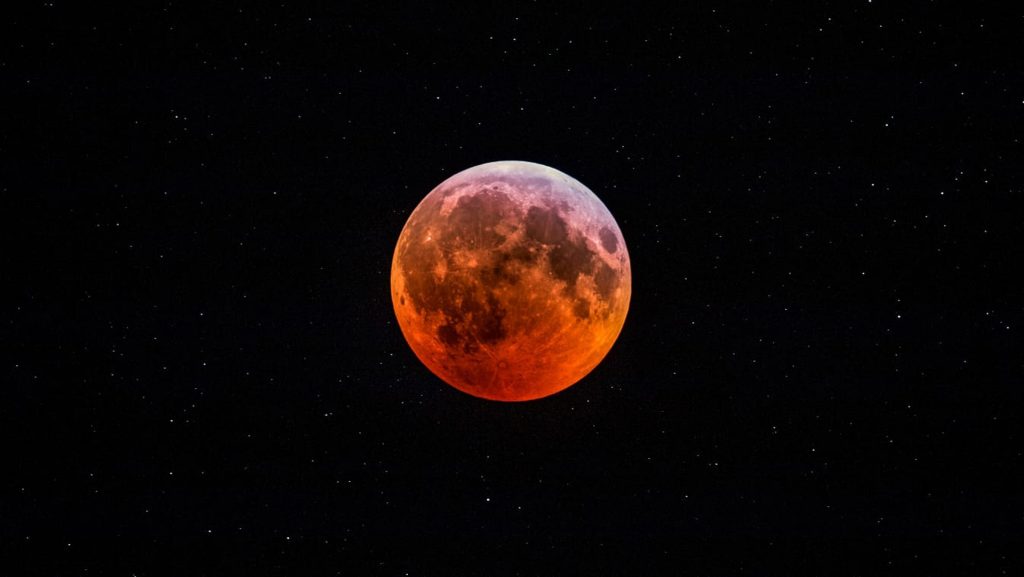2022 May 11
Total Eclipse of the Flower Moon, Early Monday 16 May
In the early hours of next Monday morning, 2022 May 16, there will be a total eclipse of the Moon. Eclipses of the Moon occur when the Full Moon (in this case the Flower Moon) passes through the cone of shadow cast by the Earth into space. Although this total lunar eclipse will not be be visible in its entirety from the UK and Ireland, it will certainly be an interesting event to watch. From London the Moon will set at mid-eclipse, but observers in the far western parts of Ireland will be able to see totality virtually in its entirety, although they will miss the closing partial phase.

The eclipse begins at 01:32 UT (02:32 BST) when the Moon enters the fainter outer part of the Earth’s shadow known as the penumbra. Visually, the Moon’s appearance isn’t affected much by its entry into the penumbra. The main phase of the eclipse begins at 02:28 UT (03:28 BST) when the Moon first enters the central, dark part of the Earth’s shadow known as the umbra. It is at this stage that it will become very obvious that a lunar eclipse is underway. From London the Moon will be 11 degrees above the south-western horizon at this time.
The eclipse becomes total at 03:29 UT (04:29 BST) and lasts for a full 1 hour 25 minutes, ending at 04:54 UT (05:54 BST), but the Moon will have set from all parts of the UK and Ireland before that time. Totality will, however, be visible in its entirety across all of South America, most of North America and parts of Africa and Europe.
Mid-eclipse is at 04:11 UT (05:11 BST), but from London the Moon will be setting at this time and only 2 minutes later from Birmingham. However, from places farther west, the Moon sets a little later: at 05:14 BST from Liverpool, 05:16 from Douglas, IoM, 05:18 from Southampton, 05:20 from Belfast, 05:26 from Swansea and 05:32 from Plymouth. Observers in Ireland will have the best view, with the Moon setting later still: at 05:28 IST (Irish Standard Time) from Dublin, 05:36 from Waterford, 05:39 from Galway and 05:43 from Cork.
From locations towards the North and East of England and in Scotland, the Moon will be setting before mid-eclipse: at 05:07 from Glasgow, 05:04 from York, 05:03 from Edinburgh, 05:00 from Newcastle and 04:58 from Inverness
As the Moon will be passing below the central part of the Earth’s umbral shadow, it is probable that the Moon’s southern limb will appear somewhat brighter during totality, fading to rather darker further north.
The partial eclipse ends at 05:55 UT (06:55 BST), when the Moon exits the umbra, but this phase of the eclipse will not be visible from anywhere in the UK and Ireland.
One never quite knows how dark or how bright a lunar eclipse will be. Everything depends on the conditions in the Earth’s upper atmosphere through which all light falling onto the shadowed Moon has to pass. There have been eclipses when the Moon has been difficult to find even with a telescope, while at other eclipses it has remained bright red or vividly coloured. The Moon appears a reddish hue because of Rayleigh scattering – the same effect that causes sunrises and sunsets to appear reddish – and the refraction of that light by the Earth’s atmosphere into its umbral shadow.
There are two interesting aspects of this particular lunar eclipse. Firstly there is every chance that this will be a relatively dark lunar eclipse if there are still significant amounts of fine volcanic ash suspended in the stratosphere as a result of the Hunga Tonga-Hunga Ha‘apai volcanic eruption on 2022 January 15.
In addition, the low altitude of the Moon from the UK and Ireland when it is eclipsed means that it will be possible to obtain pleasing images of the totally eclipsed Moon with the landscape (buildings, trees, etc.) in the foreground. Be sure to upload your images to the Observers’ Gallery pages of the BAA website.
This total lunar eclipse takes place at the Moon’s descending node in Libra, with the Moon about 34 hours before its closest approach to Earth (perigee), an event that is nowadays often called a ‘supermoon’, although this term is not particularly well defined. The Moon’s apparent diameter will be 32′ 59.8″.
Some further information on this eclipse may be found at:
https://eclipse.gsfc.nasa.gov/LEdecade/LEdecade2021.html
Dr John Mason 2022 May 11
Image credit: The total lunar eclipse of 2019 Jan 21 from Horsham, West Sussex at 05:07 UT. Image by Greg Slater with a Canon 70D + Takahashi FSQ106 on an EQ6 Pro mount, 6 seconds exposure at ISO 400. Some minor processing in Lightroom.
https://britastro.org/wp-content/uploads/2022/05/lunar-eclipse-2019-Jan-21.jpg
| The British Astronomical Association supports amateur astronomers around the UK and the rest of the world. Find out more about the BAA or join us. |
